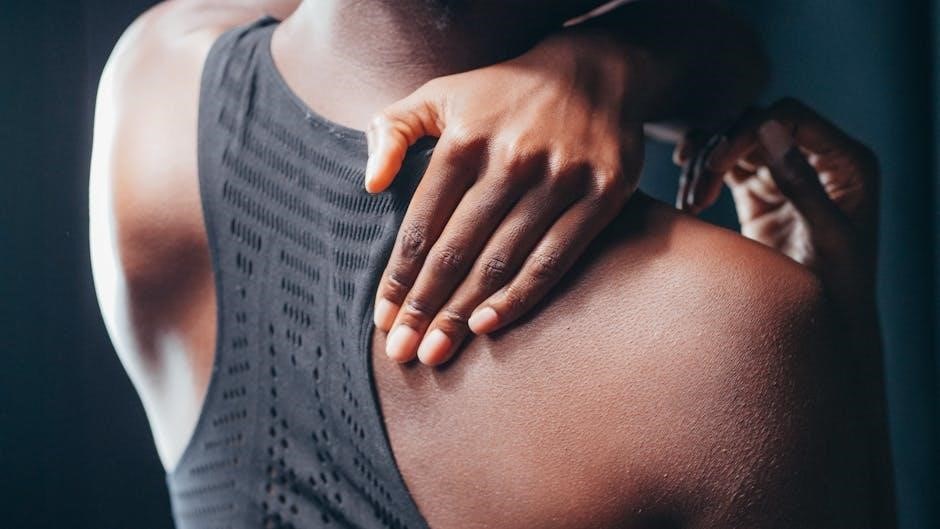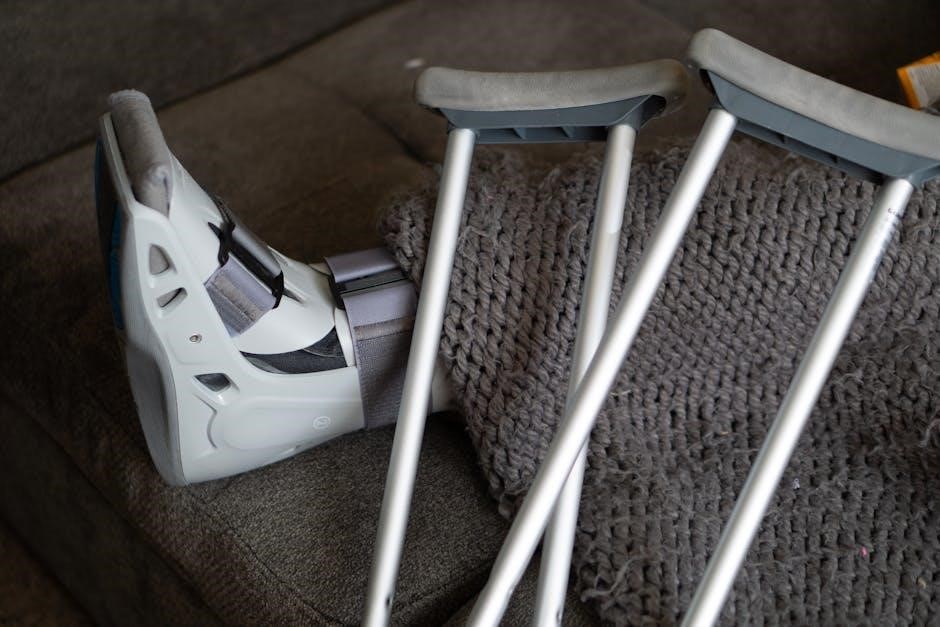A femur fracture physical therapy protocol outlines a structured rehabilitation plan to restore mobility, strength, and function post-injury or surgery, ensuring safe and effective recovery.
1.1 Overview of Femur Fractures and Their Impact
Femur fractures are significant injuries impacting mobility and quality of life, particularly in the elderly. They often result from high-energy trauma or osteoporosis, leading to prolonged recovery and increased healthcare costs. These fractures disrupt daily activities, requiring surgical intervention and rehabilitation. The societal burden is substantial, with femur fractures associated with high morbidity and mortality rates, especially in older populations.
1.2 Importance of Physical Therapy in Recovery
Physical therapy is crucial for restoring mobility, strength, and function after a femur fracture. It addresses pain, promotes healing, and prevents complications like stiffness or muscle atrophy. Early intervention enhances recovery outcomes, enabling patients to regain independence and return to daily activities. Tailored exercises improve balance, reduce fall risks, and strengthen surrounding muscles, ultimately minimizing long-term disability and healthcare costs.
Phases of Recovery in Femur Fracture Physical Therapy
The recovery process is divided into distinct phases, starting with immediate postoperative care, progressing to weightbearing and mobilization, and concluding with advanced strengthening and functional activities.
2.1 Immediate Postoperative Phase (0-2 Weeks)
The initial phase focuses on pain management, edema control, and early mobilization. Patients use assistive devices like crutches or walkers to avoid weight-bearing on the affected leg. A brace may be worn to stabilize the fracture. Gentle exercises, such as ankle pumps and straight leg raises, are introduced to maintain joint mobility and prevent stiffness. This phase lays the groundwork for progressive recovery, ensuring proper healing and readiness for weight-bearing activities.
2.2 Early Weightbearing and Mobilization Phase (2-6 Weeks)
This phase introduces gradual weight-bearing, starting with partial weight transfer and progressing to full weight-bearing as tolerated. Patients transition from walkers or crutches to canes and eventually unassisted walking. Range of motion exercises for the hip and knee are emphasized to prevent stiffness. Strengthening exercises, such as quad sets and straight leg raises, are initiated to improve muscle function and prepare for advanced mobility. Gait training focuses on restoring a normal walking pattern.
2.3 Advanced Strengthening and Functional Phase (6-12 Weeks)
This phase focuses on progressing strengthening exercises, incorporating resistance bands and functional movements. Patients perform balance and proprioception drills to enhance stability. Advanced gait training includes walking on uneven surfaces and stairs. Functional activities, such as sit-to-stand and single-leg exercises, are emphasized to improve independence. The goal is to restore pre-injury strength, mobility, and readiness for return to daily activities or sports, ensuring a seamless transition to independent living and optimal recovery outcomes.

Weightbearing Status and Progression
Weightbearing status progresses from non-weightbearing to partial and full weightbearing, guided by fracture healing and surgical stability. Transitioning from walker to cane to independent ambulation is tailored to individual recovery.
3.1 Immediate Postoperative Weightbearing Restrictions
The immediate postoperative phase typically involves non-weightbearing or partial weightbearing, depending on the fracture and surgical fixation. Patients often use crutches or walkers to avoid putting weight on the operative leg. This period, usually lasting 2-4 weeks, prioritizes pain management and swelling reduction. Surgeon approval is required before progressing to weightbearing activities. Prolonged standing or walking is avoided during the first 7-10 days to ensure proper healing and minimize complications.
3.2 Gradual Progression to Full Weightbearing
Progression to full weightbearing is tailored to the fracture type, surgical fixation, and patient tolerance. Initially, non-weightbearing or partial weightbearing is maintained, with assistive devices like crutches or walkers. As healing progresses, weightbearing is gradually increased, often starting with partial weightbearing and advancing to full weightbearing by 6-12 weeks. This progression is guided by clinical and radiographic evidence, ensuring stability and minimizing the risk of complications. Patient-specific factors, such as pain and instability, are closely monitored throughout the process.

Range of Motion Exercises
Early range of motion exercises focus on the hip and knee, progressing gradually to restore flexibility and joint mobility without causing discomfort.
4.1 Early Range of Motion for Hip and Knee
Early range of motion exercises prioritize non-weight-bearing movements to avoid discomfort. Passive and active hip flexion, extension, and knee flexion are initiated to maintain joint mobility. Gentle exercises progress gradually, focusing on pain-free ranges to prevent stiffness and promote healing. These exercises are crucial for restoring functional movement and preparing the patient for weight-bearing activities in later stages of recovery.
4.2 Progression to Advanced Mobility Exercises
Advanced mobility exercises focus on enhancing strength, flexibility, and functional movement. Patients progress to weight-bearing activities like mini squats and step-ups, improving hip and knee mechanics. Balance training and dynamic exercises are introduced to restore proprioception and stability. These exercises aim to optimize joint mobility, muscle activation, and overall physical function, preparing the patient for return to daily activities and higher-level movements.

Strengthening Exercises
Strengthening exercises target key muscle groups around the hip and knee to restore function and stability. They include resistance band work, quad sets, and progressive resistance activities.
5.1 Isometric and Closed-Chain Strengthening
Isometric exercises, such as quad sets and gluteal squeezes, are initiated early to enhance muscle strength without joint movement. Closed-chain exercises, like mini squats and step-ups, promote functional strength, improve joint stability, and reduce stress on the fracture site. These exercises are essential for rebuilding muscle control and preparing the lower extremity for weight-bearing activities, focusing on pain-free ranges to avoid compromising the healing process.
5.2 Resistance Band and Open-Chain Exercises
Resistance band exercises, such as hamstring curls and leg presses, target specific muscle groups to improve strength and endurance. Open-chain exercises, like straight leg raises and knee extensions, focus on isolated movements to enhance joint mobility and muscle activation. These exercises are progressed by increasing resistance and repetitions, ensuring proper form to avoid discomfort and promote effective rehabilitation of the femur and surrounding tissues.
5.3 Functional Strengthening for Daily Activities
Functional strengthening exercises mimic daily tasks, such as step-ups, balance drills, and sit-to-stand transitions, to enhance practical mobility. These exercises improve hip and knee stability, preparing patients for real-world activities like climbing stairs or transferring from a chair. Resistance is gradually increased using body weight or props, ensuring patients regain the strength and confidence needed for independent living and returning to their normal routines effectively.

Gait Training and Ambulation
Gait training focuses on restoring normal walking patterns, starting with assistive devices like walkers or crutches, and progressing to unassisted walking as strength and stability improve.
6.1 Initial Ambulation with Assistive Devices
Initial ambulation post-femur fracture typically begins with assistive devices like walkers or crutches to minimize weight-bearing stress. Patients are instructed to use these devices for the first 2-4 weeks to ensure proper healing. Physical therapists guide the transition from non-weight-bearing to partial weight-bearing, emphasizing safety and balance. The goal is to gradually reduce reliance on assistive devices as strength and stability improve, while preventing complications like improper gait patterns.
6.2 Progression to Independent Walking
Progression to independent walking occurs once patients achieve full weightbearing status and demonstrate sufficient strength and stability. Gait training focuses on restoring normal walking patterns, improving balance, and reducing reliance on assistive devices. This phase typically begins around 6-8 weeks post-surgery, with physical therapists tailoring exercises to address individual gait deviations and promote confidence. The goal is to achieve unassisted ambulation, ensuring safe and efficient mobility tailored to the patient’s recovery pace and specific needs.

Pain Management Strategies
Pain management incorporates pharmacological and non-pharmacological interventions, such as opioid medications, ice therapy, and therapeutic modalities, to optimize comfort and facilitate participation in rehabilitation activities safely.
7.1 Pharmacological Pain Management
Pharmacological pain management is a key component of femur fracture recovery, often involving opioid medications to reduce acute pain and inflammation. These medications are typically prescribed with careful monitoring to minimize side effects like constipation. Additionally, nonsteroidal anti-inflammatory drugs (NSAIDs) and acetaminophen may be used as adjuncts to opioids, helping to control pain while reducing reliance on stronger medications. The goal is to optimize pain control, enabling patients to participate fully in their rehabilitation program and achieve functional recovery.
7.2 Non-Pharmacological Pain Relief Techniques
Non-pharmacological pain relief techniques are essential for managing femur fracture pain without relying on medication. These include cryotherapy, such as ice packs, to reduce inflammation and discomfort. Therapeutic modalities like ultrasound and transcutaneous electrical nerve stimulation (TENS) can also alleviate pain. Additionally, gentle manual therapy and relaxation techniques, such as deep breathing exercises, help reduce stress and promote healing. These methods complement pharmacological approaches, providing holistic pain management during recovery.
Patient Education and Home Exercise Program
Patient education is crucial for successful recovery, focusing on proper home exercises, fall prevention, and wound care. Clear instructions ensure adherence and optimize rehabilitation outcomes.
8.1 Teaching Proper Home Exercises
Teaching proper home exercises involves demonstrating safe techniques, scheduling routines, and ensuring patient understanding. Emphasize non-weight-bearing exercises initially, progressing to weight-bearing as tolerated. Patients learn to use assistive devices and monitor pain. Clear instructions and visual aids enhance adherence. Regular follow-ups assess progress and address concerns, ensuring exercises are performed correctly to avoid complications and promote optimal recovery.
8.2 Fall Prevention and Safety Measures
Fall prevention is crucial for patients recovering from femur fractures. Assess the home environment to remove tripping hazards, ensure proper lighting, and install handrails in bathrooms. Educate patients on safe transfers, use of assistive devices, and proper footwear. Emphasize balance training and cautious movement to minimize fall risks, promoting independence while ensuring safety during the recovery process.

Common Complications and Considerations
Common complications include hardware failure, infection, or delayed healing. Patient factors like diabetes or osteoporosis may slow recovery. Addressing these issues early is critical for optimal outcomes.
9.1 Managing Surgical Site Complications
Surgical site complications, such as infection or wound dehiscence, require prompt intervention. Monitoring for signs of infection, like redness or swelling, is crucial. Proper wound care, antimicrobial dressings, and adherence to sterile protocols are essential. Collaboration between surgeons and physical therapists ensures early detection and management. Patient-specific factors, such as diabetes or compromised immune systems, may necessitate tailored approaches to prevent and address these complications effectively during the recovery process.
9.2 Addressing Fracture-Specific Rehabilitation Challenges
Femur fracture rehabilitation presents unique challenges, including limited mobility, pain, and swelling. Early identification of fracture-specific issues, such as malunion or delayed healing, is critical. Therapists employ pain management techniques and gentle exercises to maintain joint mobility without stressing the fracture site. Patient compliance with weightbearing restrictions and exercise regimens is essential to avoid complications and ensure proper healing, optimizing functional outcomes and reducing long-term disability.
Expected Outcomes and Recovery Timeline
Most patients achieve significant functional improvement within 6-12 months, with restored mobility, strength, and return to daily activities. Recovery timelines vary based on fracture severity and rehabilitation adherence.
10.1 Functional Outcomes and Return to Activity
Patients typically regain independence in daily activities within 6-12 months post-injury. Recovery focuses on restoring mobility, strength, and balance, enabling return to activities like walking, climbing stairs, and driving. Progression to full weightbearing and functional exercises enhances gait mechanics and reduces reliance on assistive devices. Individualized physical therapy ensures tailored goals, improving overall quality of life and facilitating a safe transition back to pre-injury activities.
10.2 Patient-Reported Outcomes and Satisfaction
Patients often report significant improvements in mobility and pain reduction following femur fracture rehabilitation. Satisfaction levels are influenced by the effectiveness of therapy, communication with healthcare providers, and achievement of personal recovery goals. Patient-reported outcomes highlight enhanced quality of life, with many regaining independence in daily activities and returning to pre-injury functions, demonstrating the efficacy of tailored physical therapy protocols.
The femur fracture physical therapy protocol is a comprehensive approach promoting optimal recovery, emphasizing adherence to structured guidelines and continued patient engagement for long-term functional restoration.
11.1 Summary of Key Rehabilitation Principles
The femur fracture rehabilitation protocol emphasizes phased recovery, progressing from non-weightbearing to full weightbearing, with a focus on range of motion, strengthening, and gait training. Early mobilization and isometric exercises promote muscle activation without stress on the fracture site. Gradual resistance and functional exercises enhance strength and mobility. Pain management, fall prevention, and patient education are integral to ensuring safe and effective recovery, tailored to individual needs and fracture severity.
11.2 Final Recommendations for Optimal Recovery
Adherence to a structured physical therapy protocol is crucial for optimal recovery post-femur fracture. Regular attendance at therapy sessions and consistent performance of home exercises are essential. Monitoring for complications and adjusting the protocol as needed ensures progress. Patient education on proper techniques and safety measures minimizes risks. A phased approach, emphasizing gradual weightbearing and functional strengthening, promotes long-term mobility and reduces recurrence of injury, ensuring a full return to daily activities and improved quality of life.
